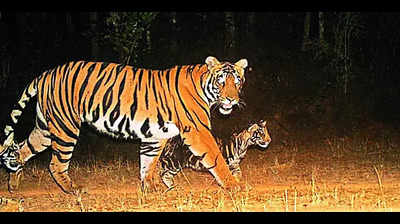Tigers: Tigers killing cattle in Similipal Tiger Reserve | Bhubaneswar News


Bhubaneswar: Wildlife officials in Similipal Tiger Reserve have reported at least 35 cases of cattle hunting by Royal Bengal Tigers in the north core region between January and July. With tigers from the south core dispersing due to an increase in population, tigers, mostly the adult males, are trying to explore new territory in the north division, where villages are situated in close proximity.
Anup Nayak, former member secretary of National Tiger Conservation Authority and former field director of Similipal, said tigers dispersing within Similipal habitat is a sign of a healthy and growing population.“If the cattle hunting spree increases, it is not good. The authorities should work for prey augmentation in the northern region. Also, poaching activities should be brought under check because the north core may carry more tigers in future,” he added.
“The dispersing tigers often encounter cattle in the buffer zone. We can’t call cattle killing an instinctive one as the tigers don’t stray into human habitation and kill them or look for exclusive cattle prey,” Similipal field director Prakash Gogineni said. “We will give compensation to the villagers based on the type and size of the prey. For calves, the compensation is less and there are different slabs for buffalo and cows as well,” Gogineni added.
In the north division, villagers leave cattle in the forest and the latter often stray deep into the jungles for grazing and encounter the tigers. Thus, they become easy prey for the tigers.
This month there hasn’t been a single cattle kill report so far.
Similipal, spread over 2,750 sqkm, is home to 27 adult tigers, of which 15 are melanistic (black striped). According to the tiger estimation conducted by the government in 2022, a male tiger (T26) was spotted for the first time in north Similipal. The number of big cats in north Similipal has further increased. Now, six tigers are spotted in the northern core, of which T34, T24 and T40 are female and T26, T44 and T46 male.
Officials said Similipal’s deep core (south division) comprises four ranges – national park range, Jenabil range, Bhanjabasa range and Upper Barakamada range. In the north division, the core has two ranges.
We also published the following articles recently
The black tiger in Similipal, Odisha is a unique Bengal tiger variant caused by a mutation in the Taqpep gene. Researchers found this rare genetic trait linked to inbreeding in the isolated population. Conservation efforts include anti-poaching measures, community involvement, and plans for a melanistic tiger safari to boost wildlife tourism.
The article discussed how responsible tourism aided tiger conservation by raising awareness, generating funds, and empowering local communities. It highlighted that sustainable practices helped protect habitats and curbed illegal activities. However, challenges such as overcrowding and inadequate infrastructure emerged, requiring continuous efforts and innovative solutions to balance tourist demand and ecological sustainability.
MLAs called on the government to designate the Mhadei Wildlife Sanctuary as a tiger reserve during discussions on forest department grants. Opposition Leader Yuri Alemao highlighted the lack of a survey on human impact, while BJPs Taleigao MLA Jennifer Monserrate emphasized prioritizing Goa’s interests. Other MLAs also urged compliance with HC orders for Mhadei’s conservation.














